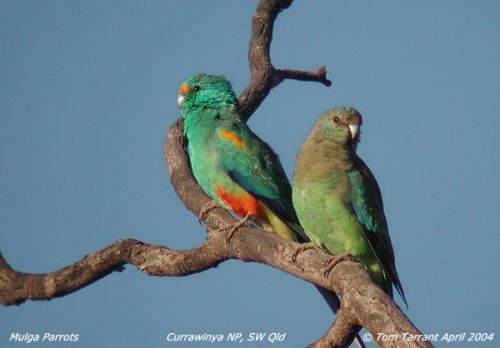(→External Links: Multiple GSearches combined) |
|||
| (9 intermediate revisions by 6 users not shown) | |||
| Line 1: | Line 1: | ||
| − | + | [[Image:Mulga_Parrot.jpg|thumb|500px|right|Male left, female right<br />Photo by {{user|Tom+Tarrant|Tom Tarrant}} <br />Currawinya National Park, SW [[Queensland]], [[Australia]], April 2004]] | |
| − | [[Image:Mulga_Parrot.jpg|thumb| | + | ;[[: Category:Psephotus|Psephotus]] varius |
| + | |||
==Identification== | ==Identification== | ||
| − | + | [[Image:Mulga Parrot Fem 00000001.jpg|thumb|350px|right|Female<br />Photo by {{user|Ken+Doy|Ken Doy}}<br />SW [[Queensland]], October 2017]] | |
| + | 27–28 cm (10½-11 in)<br /> | ||
| + | '''Male''' | ||
| + | *Bright green overall plumage | ||
| + | *Yellow frontal band | ||
| + | *Red hindcrown | ||
| + | *Yellow lesser wing-[[Topography#General Anatomy|coverts]] | ||
| + | *Dark blue outer wing-coverts<br /> | ||
| + | '''Female'': similar but duller. Lacks the yellow frontal band of the male | ||
| + | ==Distribution== | ||
| + | Interior of southern [[Australia]] mostly south of tropic of capricorn. Found from western [[Western Australia]] to central [[New South Wales]]. | ||
| − | Mulga Parrots | + | ==Taxonomy== |
| + | [[Image:Mulga Parrots.jpg|thumb|350px|right|Photo by {{user|Ken+Doy|Ken Doy}}<br />SW [[Queensland]], April 2018]] | ||
| + | This is a [[Dictionary_M-S#M|monotypic]] species<sup>[[#References|[1]]]</sup> according to some authorities, others include subspecies ''orientalis'' and ''dulciei''. | ||
| + | ==Habitat== | ||
| + | Arid lightly wooded grassland, mallee and scrub; often near water such as riverbeds. | ||
| + | ==Behaviour== | ||
| + | ====Diet==== | ||
| + | Their diet consists mostly of seeds from grass, herbs, trees and shrubs; also fruits,mistletoe, blossoms, and flower buds, and various plant and vegetable matter. Insects and insect larvae are also consumed. | ||
| + | ====Breeding==== | ||
| + | They nest in a hollow limb or tree hole. The clutch consists of 4 - 6 eggs which are incubated for about 19 days. After 4 - 5 weeks the young fledge and are independent after approx. another 2 - 3 weeks. | ||
| + | ====Movements==== | ||
| + | Sedentary or locally nomadic. | ||
| + | ==References== | ||
| + | #{{Ref-Clements6thAug17}}#Handbook of the Birds of the World Alive (retrieved Oct 2017) | ||
| + | #Friends of the Australian Arid Lands Botanic Garden | ||
| + | #BF Member Observations | ||
| + | {{ref}} | ||
| + | ==External Links== | ||
| + | {{GSearch|"Psephotus varius" {{!}} "Mulga Parrot"}} | ||
| + | {{GS-checked}}1 | ||
| + | <br /> | ||
| + | <br /> | ||
| − | + | [[Category:Birds]][[Category:Psephotus]] | |
| − | |||
| − | [[Category: | ||
Latest revision as of 20:05, 22 April 2023

Photo by Tom Tarrant
Currawinya National Park, SW Queensland, Australia, April 2004
- Psephotus varius
Identification
27–28 cm (10½-11 in)
Male
- Bright green overall plumage
- Yellow frontal band
- Red hindcrown
- Yellow lesser wing-coverts
- Dark blue outer wing-coverts
'Female: similar but duller. Lacks the yellow frontal band of the male
Distribution
Interior of southern Australia mostly south of tropic of capricorn. Found from western Western Australia to central New South Wales.
Taxonomy
This is a monotypic species[1] according to some authorities, others include subspecies orientalis and dulciei.
Habitat
Arid lightly wooded grassland, mallee and scrub; often near water such as riverbeds.
Behaviour
Diet
Their diet consists mostly of seeds from grass, herbs, trees and shrubs; also fruits,mistletoe, blossoms, and flower buds, and various plant and vegetable matter. Insects and insect larvae are also consumed.
Breeding
They nest in a hollow limb or tree hole. The clutch consists of 4 - 6 eggs which are incubated for about 19 days. After 4 - 5 weeks the young fledge and are independent after approx. another 2 - 3 weeks.
Movements
Sedentary or locally nomadic.
References
- Clements, J. F., T. S. Schulenberg, M. J. Iliff, D. Roberson, T. A. Fredericks, B. L. Sullivan, and C. L. Wood. 2017. The eBird/Clements checklist of birds of the world: v2017, with updates to August 2017. Downloaded from http://www.birds.cornell.edu/clementschecklist/download/
- Handbook of the Birds of the World Alive (retrieved Oct 2017)
- Friends of the Australian Arid Lands Botanic Garden
- BF Member Observations
Recommended Citation
- BirdForum Opus contributors. (2024) Mulga Parrot. In: BirdForum, the forum for wild birds and birding. Retrieved 12 May 2024 from https://www.birdforum.net/opus/Mulga_Parrot
External Links
GSearch checked for 2020 platform.1





